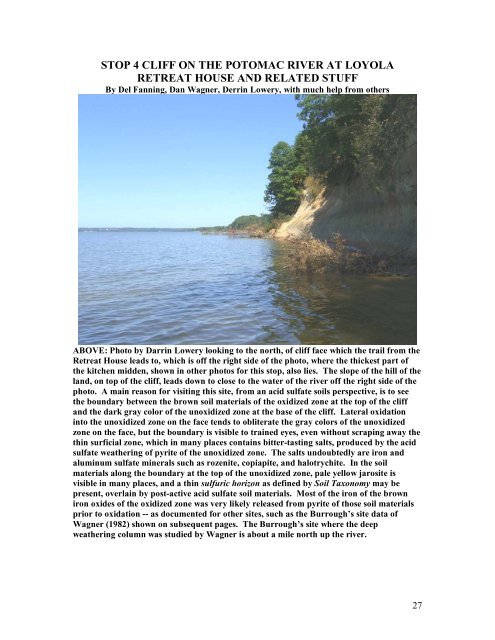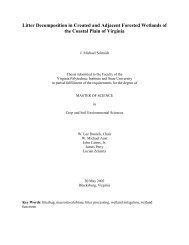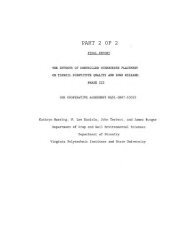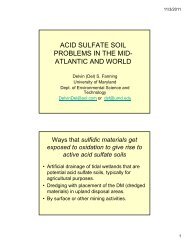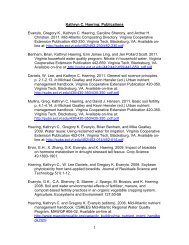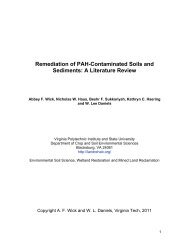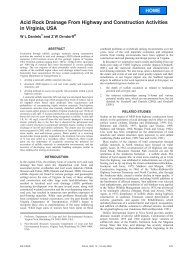ACID SULFATE SOILS - Sawgal.umd.edu - University of Maryland
ACID SULFATE SOILS - Sawgal.umd.edu - University of Maryland
ACID SULFATE SOILS - Sawgal.umd.edu - University of Maryland
Create successful ePaper yourself
Turn your PDF publications into a flip-book with our unique Google optimized e-Paper software.
STOP 4 CLIFF ON THE POTOMAC RIVER AT LOYOLA<br />
RETREAT HOUSE AND RELATED STUFF<br />
By Del Fanning, Dan Wagner, Derrin Lowery, with much help from others<br />
ABOVE: Photo by Darrin Lowery looking to the north, <strong>of</strong> cliff face which the trail from the<br />
Retreat House leads to, which is <strong>of</strong>f the right side <strong>of</strong> the photo, where the thickest part <strong>of</strong><br />
the kitchen midden, shown in other photos for this stop, also lies. The slope <strong>of</strong> the hill <strong>of</strong> the<br />
land, on top <strong>of</strong> the cliff, leads down to close to the water <strong>of</strong> the river <strong>of</strong>f the right side <strong>of</strong> the<br />
photo. A main reason for visiting this site, from an acid sulfate soils perspective, is to see<br />
the boundary between the brown soil materials <strong>of</strong> the oxidized zone at the top <strong>of</strong> the cliff<br />
and the dark gray color <strong>of</strong> the unoxidized zone at the base <strong>of</strong> the cliff. Lateral oxidation<br />
into the unoxidized zone on the face tends to obliterate the gray colors <strong>of</strong> the unoxidized<br />
zone on the face, but the boundary is visible to trained eyes, even without scraping away the<br />
thin surficial zone, which in many places contains bitter-tasting salts, produced by the acid<br />
sulfate weathering <strong>of</strong> pyrite <strong>of</strong> the unoxidized zone. The salts undoubtedly are iron and<br />
aluminum sulfate minerals such as rozenite, copiapite, and halotrychite. In the soil<br />
materials along the boundary at the top <strong>of</strong> the unoxidized zone, pale yellow jarosite is<br />
visible in many places, and a thin sulfuric horizon as defined by Soil Taxonomy may be<br />
present, overlain by post-active acid sulfate soil materials. Most <strong>of</strong> the iron <strong>of</strong> the brown<br />
iron oxides <strong>of</strong> the oxidized zone was very likely released from pyrite <strong>of</strong> those soil materials<br />
prior to oxidation -- as documented for other sites, such as the Burrough’s site data <strong>of</strong><br />
Wagner (1982) shown on subsequent pages. The Burrough’s site where the deep<br />
weathering column was studied by Wagner is about a mile north up the river.<br />
27


